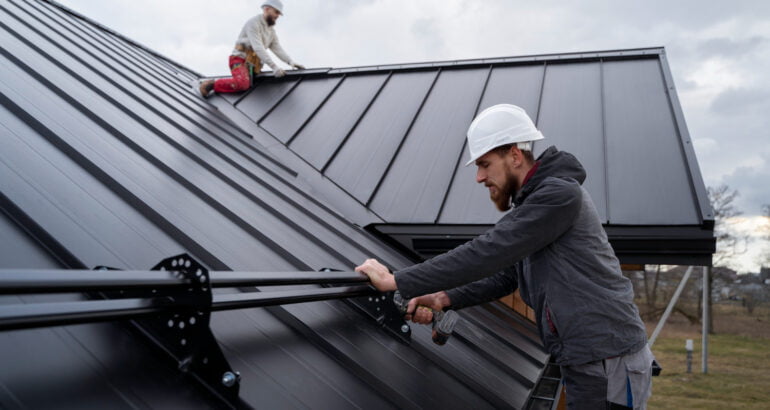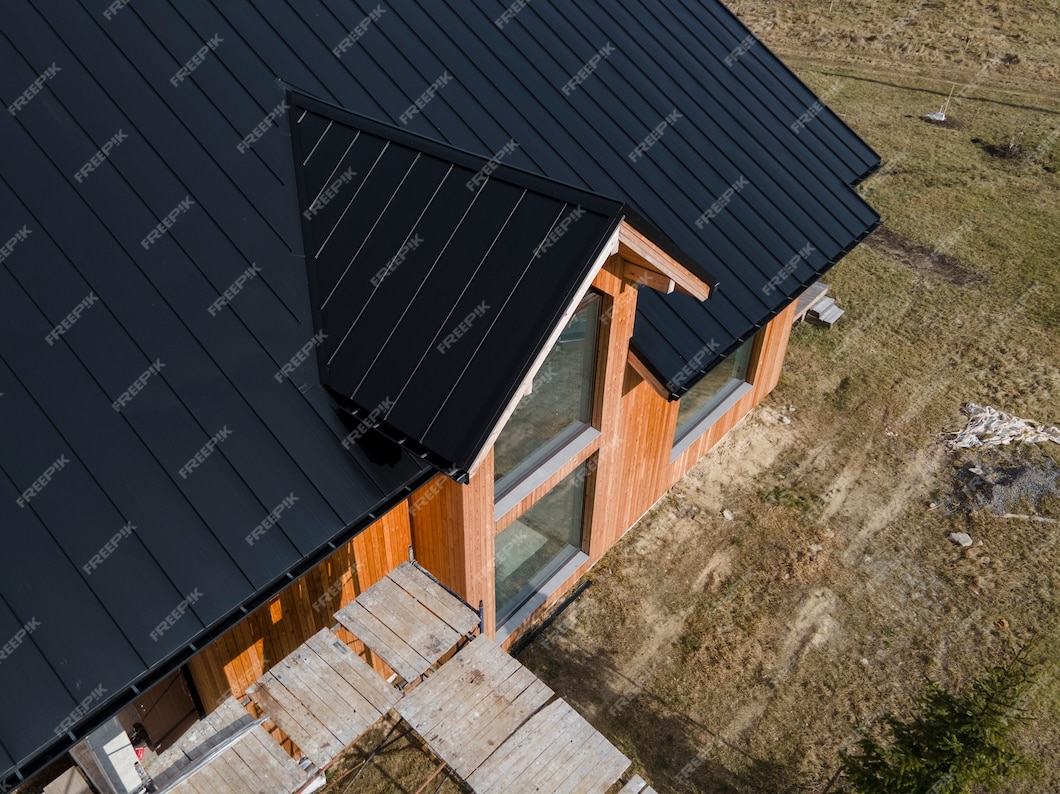
Rolled roofing is a type of roofing material that is commonly used on low-slope or flat roofs. It’s a cost-effective option that is easier to install and requires minimal maintenance. Rolled roofing is made of the same materials as traditional asphalt shingles, but it’s thinner and comes in large rolls.

One of the benefits of rolled roofing is its ease of installation. It can be quickly installed by a professional roofing contractor, such as Freddy & Son Roofing, or by a skilled DIY homeowner. An added benefits is that rolled roofing is a durable option that lasts decades with the proper maintenance. It’s resistant to weather damage and can withstand high winds and heavy rain.
Several types of rolled roofing are available on the market, including mineral-surfaced, smooth-surfaced, and self-adhering. Mineral-surfaced rolled roofing is the most common type and is made of fiberglass or organic mat coated with asphalt and topped with mineral granules. Smooth-surfaced rolled roofing is made of the same materials but does not have the mineral granule layer, giving it a smoother appearance. Self-adhering rolled roofing is a newer option that eliminates the need for hot tar or roofing cement during installation.
Types of Roofs for Rolled Roofing
Rolled roofing is a versatile roofing material that can be used on a variety of roofs. It is a popular choice for low-sloped roofs, as well as flat roofs. While, rolled roofing can be used on sloped roofs, it may not be the best option for roofs with a steep pitch.
Sloped Roofs
Sloped roofs require a different type of roofing material that is designed to handle the angle of the roof. However, if the slope of the roof is not too steep, rolled roofing can be a cost-effective solution. Freddy & Son Roofing, a reputable roofing company, can advise homeowners on the best roofing material for their sloped roofs.
Flat Roofs
Flat roofs are a popular choice for commercial buildings but can also be found in residential homes. Rolled roofing is a great option for flat roofs because it is easier to install and provides a durable, waterproof surface.
Low-Sloped Roofs
Low-sloped roofs are a common type of roof found on residential homes. Rolled roofing is an excellent choice for low-sloped roofs because it is easier to install and provides a waterproof surface. Roofing contractors rolled roofing for low-sloped roofs because it is a cost-effective solution that can be installed quickly.
Installation Guide

Installing roll roofing is a practical solution when appearance isn’t as important, but durability is. Adding a roof to smaller structures like workshops, sheds, and garages is also a low-cost way. Here is a step-by-step installation guide for roll roofing:
- Gather Materials: The first step in the installation process is to gather all your materials and tools. These include roll roofing, roofing nails, roofing cement, roofing trowel, chalk line, utility knife, and a hammer.
- Prepare the Roof Surface: Before installing roll roofing, make sure the roof surface is clean, smooth, and free of debris. Any existing roofing material should be removed.
- Install Drip Edge: Install the drip edge along the eaves of the roof. This will help prevent water from seeping under the roofing material.
- Measure and Cut the Roll Roofing: Measure the roof length and add an additional 6 inches to allow for an overhang. Roll out the roofing material and use a chalk line to mark the length. Cut the roll roofing to the appropriate length.
- Apply Adhesive: Apply roofing cement to the roof surface using a trowel.
- Install the Roll Roofing: Carefully roll the roofing material onto the surface. Make sure it is aligned with the chalk line. Press the roofing material into the adhesive.
- Secure the Roll Roofing: Use roofing nails to secure the roofing material in place.
- Apply Roofing Cement: Apply roofing cement to the edges of the roofing material and to the seams between each roll of roofing material.
It is recommended to follow the manufacturer’s instructions when installing roll roofing. It is also important to work in moderate temperatures between 45°F (7°C) and 95°F (35°C) to ensure proper adhesion.
Choosing the Right Roofing for Your Structure
When it comes to roofing, there are many options available in the market. Choosing the right roofing for your structure is essential to ensure its longevity and durability. You may visit your local Lowes or Home Depot to find great rolled roofing options or consult a professional.
Before choosing a roofing material, it is important to consider the structure’s purpose, location, and climate. For instance, a house in a cold climate may require a different roofing material than a house in a hot and humid climate. Similarly, a commercial building may require a different roofing material than a residential building.
When it comes to choosing the right roofing material, here are some factors to consider:
- Durability: The roofing material should be able to withstand the elements and last for a long time without requiring frequent repairs or replacements.
- Cost: The roofing material cost should be within your budget, and you should also consider the long-term maintenance costs.
- Energy efficiency: Some roofing materials are more energy-efficient than others, which can help reduce your energy bills.
- Aesthetics: The roofing material should complement your structure’s overall design and style.
In addition to these factors, it is also important to consider the structure’s purpose. For example, a garage or shed may not require the same level of durability as a house or commercial building. Rolled roofing may be a suitable option for outbuildings like shops, sheds, and garages, but it may not be the best option for unoccupied structures or buildings that require a higher level of durability.
Choosing the right roofing material for your structure is crucial to ensure its longevity and durability.
Pros and Cons of Rolled Roofing
Rolled roofing is a popular roofing material that is known for its affordability and ease of installation. However, it also has some drawbacks that homeowners should be aware of before deciding to use it. This section will discuss the pros and cons of rolled roofing.
Pros
- Inexpensive: Rolled roofing is one of the most affordable roofing materials available in the market. It is a great option for homeowners who are on a tight budget and cannot afford more expensive roofing materials.
- Easy to Install: Rolled roofing is also easier to install, which makes it a popular choice for DIY enthusiasts. The installation process is straightforward and can be completed in a few hours.
- Lightweight: Rolled roofing is also very lightweight, which makes it a good option for roofs that cannot support heavier materials. It is also easier to transport and handle compared to other roofing materials.
Cons
- Shorter Lifespan: One of the biggest drawbacks of rolled roofing is its short lifespan. It typically lasts 5 to 10 years, significantly less than other roofing materials. This means that homeowners will have to replace their roofs more frequently, which can be costly in the long run. However, reputable roofing contractors my use materials that lost a lot longer.
- Less Durable: Rolled roofing is also less durable than other roofing materials. It is more susceptible to damage from weather elements such as hail, wind, and rain. This means that homeowners may have to repair their roofs more frequently, which can also be costly.
- Limited Aesthetic Options: Rolled roofing is also limited in terms of aesthetic options. It is only available in a limited number of colors and styles, so homeowners may be unable to find a style that suits their preferences.
Overall, rolled roofing can be a good option for homeowners on a tighter budget who need an easy-to-install roofing material.
DIY
Some homeowners may choose to install rolled roofing themselves to save on labor costs. However, having experience and knowledge of roofing installation is important to ensure a proper installation. Improper installation can lead to leaks and other roofing issues.
Overall, rolled roofing can be a cost-effective option for roofing needs. It is important to consider all the costs associated with rolled roofing if you choose to DIY, and understand that going with professional contractors may mean a londer lifespan and more durability.
Understanding Warranties and Lifespans
Understanding warranties and lifespans is crucial for homeowners when it comes to rolled roofing. Rolled roofing typically comes with a manufacturer’s warranty that covers defects in materials and workmanship. The length of the warranty can vary depending on the manufacturer and the type of rolled roofing.
For example, GAF offers a Lifetime Limited Warranty on their Timberline® Lifetime Shingles. This warranty covers the shingles for as long as the original owner owns the property. However, it’s important to note that the warranty may only cover manufacturing defects and usually doesn’t cover damage caused by weather, improper installation, or lack of maintenance.
In addition to manufacturer warranties, some roofing contractors may offer workmanship warranties. These warranties cover any issues that arise due to the contractor’s installation of the rolled roofing. For instance, Freddy & Son Roofing may offer a workmanship warranty that covers any leaks or other issues caused by their rolled roofing installation. Homeowners should always ask their contractors about any workmanship warranties they offer and make sure to get the warranty in writing.
Commercial vs Residential Rolled Roofing
Rolled roofing is a cost-effective and easy-to-install roofing material that is commonly used in both commercial and residential buildings. However, some key differences between commercial and residential rolled roofing are worth considering before making a decision.
Residential Rolled Roofing
Residential rolled roofing is typically used for low-slope or flat roofs in homes. It is made of asphalt shingles and comes in 36 inches-wide and 33 feet long rolls. Residential rolled roofing is easier to install and can be done by a single person. It is also lightweight and can be installed over an existing roof.
Commercial Rolled Roofing
Commercial rolled roofing is typically used for flat roofs in commercial buildings. It is made of various materials, including EPDM, TPO, and PVC. Commercial rolled roofing comes in larger rolls than residential rolled roofing and requires a team of professionals to install.
Key Differences
The table below summarizes the key differences between commercial and residential rolled roofing:
| Criteria | Residential | Commercial |
|---|---|---|
| Materials | Asphalt | EPDM, TPO, PVC |
| Roll Size | 36″ x 33′ | Larger rolls |
| Installation | Easier | Requires a team of professionals |
| Durability | Less durable | More durable |
| Cost | Less expensive | More expensive |
In summary, commercial and residential rolled roofing have advantages and disadvantages. Homeowners who are looking for an affordable and easy-to-install roofing material should consider residential rolled roofing, while business owners who are looking for a durable and long-lasting roofing material should consider commercial rolled roofing. Freddy & Son Roofing recommends both types of rolled roofing and can help homeowners and business owners make an informed decision.



